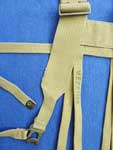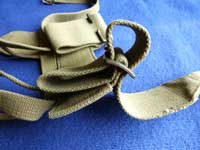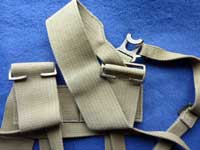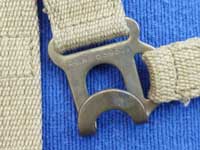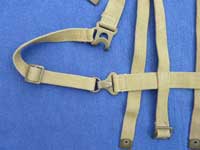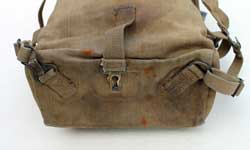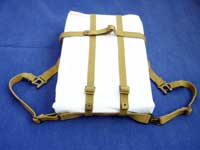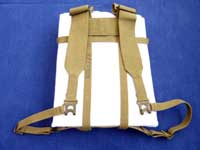| Karkee Web Home Page | Officer's Main Page | W.E.O. Main Page | W.E.I.O. Main Page |
Web Equipment, Infantry Officers
Coat Carrier
As with the 1916 pattern, the weave pattern of Mills Equipment for Officers was fine, involving singled warp threads, rather than the usual doubled threads.
CARRIER, COAT, W.E., I.O.
When Mills had finished developing Pattern 1908 Web Infantry Equipment, they turned their attention to supplying the Territorial Force (T.F.), newly formed on 1st April, 1908. Their units had to purchase their accoutrements, using grants from their County Territorial Associations who, in turn, were funded by the War Office. The T.F. therefore had to eke out their funds more carefully than the Regular Army.
At 4s 6d (in 1910, or 22.5p today), the most expensive component of Patt. ’08 W.E. was the Pack, so Mills stripped it right back from an “envelope” to an assembly of straps, tabs and buckles, which cost around 5¾ d (or about 0.025p today). Lethern refers to this as a Greatcoat carrier, but also elsewhere as a Coat carrier and a Patent was applied for in early 1909, the drawing being from this Patent. The prime purpose of the ’08 Pack was to carry the Greatcoat and Tin, mess, D.S., along with various small articles of Clothing & Necessaries. The Coat carrier only allowed the Mess tin in its Cover to be attached and whatever could be put into the pockets of the Greatcoat.
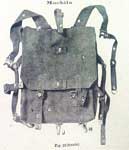
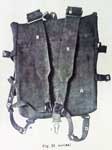
 Both Web Equipment, Officers, Experimental and Web Equipment, Infantry Officers were provided with a Rucksack. The design of these were first developed by M.E.Co. as the Mochila for the Portuguese Naval Equipamento Mills m/1914, seen at left and centre and published in 1913. This design also included a Rêde do Capote – a Coat carrier - for the officers, though this was of Patt. ’08 form and attached directly to the Braces, in the same way as Patt. ’08.
Both Web Equipment, Officers, Experimental and Web Equipment, Infantry Officers were provided with a Rucksack. The design of these were first developed by M.E.Co. as the Mochila for the Portuguese Naval Equipamento Mills m/1914, seen at left and centre and published in 1913. This design also included a Rêde do Capote – a Coat carrier - for the officers, though this was of Patt. ’08 form and attached directly to the Braces, in the same way as Patt. ’08.

 Portuguese Marines were equipped with the m/1914 pattern, when they were sent to Angola in September 1914. Despite this early appearance of the design, the covering Patent was not applied for until 1915, these drawings being from that Patent. This Rucksack had detachable shoulder straps, but these - as a “first” - were fitted with Haversack hooks. It also included a revision to the 1909 Coat carrier design, to which the detachable shoulder straps could now be buckled at the top and hooked on – both sides – at the base. M.E.Co. have drawn the top connection oddly, with the sliding 2-inch buckles on the tabs, rather than the shoulder straps, which was the norm.
Portuguese Marines were equipped with the m/1914 pattern, when they were sent to Angola in September 1914. Despite this early appearance of the design, the covering Patent was not applied for until 1915, these drawings being from that Patent. This Rucksack had detachable shoulder straps, but these - as a “first” - were fitted with Haversack hooks. It also included a revision to the 1909 Coat carrier design, to which the detachable shoulder straps could now be buckled at the top and hooked on – both sides – at the base. M.E.Co. have drawn the top connection oddly, with the sliding 2-inch buckles on the tabs, rather than the shoulder straps, which was the norm.
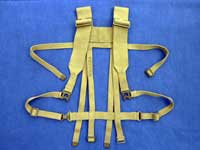
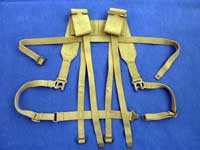
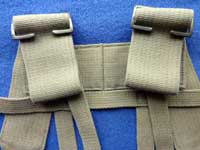 The photo far left is of the front of a Carrier intended for use with Web Equipment, Infantry Officers, given that it was made in 1926 by M.E.Co. Near left is a rear view. No mention of a Coat carrier had been noted previously. We are indebted to the Lee Moorhouse / Steve Britton Collection. Photographs © Lee Moorhouse, 2017.
The photo far left is of the front of a Carrier intended for use with Web Equipment, Infantry Officers, given that it was made in 1926 by M.E.Co. Near left is a rear view. No mention of a Coat carrier had been noted previously. We are indebted to the Lee Moorhouse / Steve Britton Collection. Photographs © Lee Moorhouse, 2017.
The key part of the Carrier, seen at right, is a length of 2-inch webbing, doubled and stitched into a pad for more stiffness, acting also as a “distance piece” between a pair of 2–in. / 1–in. reduction woven shoulder straps sandwiched between the two layers of the “distance piece”.
Note the “corded” weave on the flares, as seen on R.A.F. Web Equipment for Officers.
A Buckle, brass, 2-in. is threaded onto the strap, but is held in a stitched bight of the strap, before the assembly was stitched up. The shoulder straps have an outward splay and also sandwiched into the pad are two vertical load straps in narrow webbing. Corresponding Buckles, brass, ¾-in. are attached to the lower ends of the vertical straps, adjacent to the wearer, with Tips, brass, ¾-in. at the other ends.
Although captive, the shoulder straps are still adjustable by pulling a second, loose bight of the flare back through the buckle. This method was first used on the Rucksack of the Portuguese Naval Equipamento Mills m/1914, successively then on Belgian M-1915 Uitrusting Mills, Royal Navy Patt. ’19 W.E., R.A.F. Patt. ’25 W.E. and South African W.E., Braithwaite.
The Mills’ patented Hooks, haversack, brass are stitched to the tapered ends of the reduction woven shoulder straps. Counter straps, ¾-in. wide, are stitched to the loops on the sides of the Hooks. These were also first seen on Portuguese m/1914.
A horizontal, 1-inch wide strap was stitched above the load strap buckles, forming a second “distance piece” with the pad. On its left end, this horizontal strap had a brass “D”, to which the left-hand, adjustable counter strap was permanently attached. The right hand end of the distance piece had a hook at the other end.
Note that, when laid flat, the hook is open to the forward side of the wearer. For correct function, it would appear that this horizontal strap was to be turned upwards, to lie across the “base” of the load. The hook is then open, facing downwards, allowing the right-hand, adjustable counter strap to be attached more readily.
Compare with the base of a Patt. ’19 Rucksack, illustrated at right, the open side of the hook is orientated facing downwards from the Rucksack. Collection of Jean Lummerzheim. Photograph © Jean Lummerzheim, 2012.
To achieve this with the T.F. Coat carrier, the loop / hook cross-strap ideally lay across the “base” of the load, as here on the T.F. Coat carrier, albeit this had buckles for the diagonal straps of the T.F. Cartridge carriers.
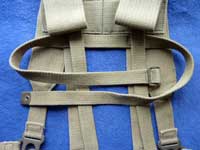 The folded coat was firmly carried by the vertical load straps, but it could fall out sideways. Accordingly, two horizontal ¾-inch straps were stitched to the vertical straps, the one adjacent to the upper pad, illustrated here, with a second one positioned 2/3rds of the way down, between the pad and bottom distance piece.
The folded coat was firmly carried by the vertical load straps, but it could fall out sideways. Accordingly, two horizontal ¾-inch straps were stitched to the vertical straps, the one adjacent to the upper pad, illustrated here, with a second one positioned 2/3rds of the way down, between the pad and bottom distance piece.
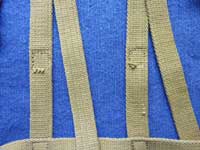 Curiously, MECo’s Patent drawings of Coat carriers and the Portuguese equivalent all have only a single horizontal strap, in the position where a lower horizontal load strap has been cut off this example. The stitching on the top strap looks to be original, so it is not the missing lower strap being re-located higher up. Perhaps the upper strap was simply a de luxe measure, on what was a Private Purchase?
Curiously, MECo’s Patent drawings of Coat carriers and the Portuguese equivalent all have only a single horizontal strap, in the position where a lower horizontal load strap has been cut off this example. The stitching on the top strap looks to be original, so it is not the missing lower strap being re-located higher up. Perhaps the upper strap was simply a de luxe measure, on what was a Private Purchase?
The Rucksack had five external straps, so that a Great Coat could be rolled and strapped, “horse shoe roll” fashion, around the top and sides of the Rucksack. The provision of an alternative to this, in the form of a Coat carrier, is therefore a little puzzling. Kitted out in a full set of webbing, it is difficult to see in what circumstances an officer would swap the greater carrying capacity of the Rucksack for a Coat carrier. The Haversack could be carried dorsally, so an equivalent Battle Order was already catered for.
The Coat carrier was not illustrated in Mills 1919-20 official photographs of W.E., I.O. This suggests it was a peacetime addition to Mills’ product. In that it was of Rucksack form, an officer did not need to wear any other part of the Pattern. Perhaps it was simply to allow a Greatcoat, or Raincoat to be carried, “rucksack fashion”, as a precaution against weather changes, say when observing manoeuvres, rather than participating in them, let alone when in action in the field?
However, the Portuguese Army apparently did not wish to burden their officers with a Rucksack in the field. The sub-section, Equipamenta para Oficiais, of the m/1914 handbook, only has a Coat carrier for their officers, as illustrated here, along with an Officers’ Haversack, which could be worn dorsally. Conversely, the Rank & File were provided with a different Haversack, which could only be worn at the side, so they had to wear the Rucksack – or not!!
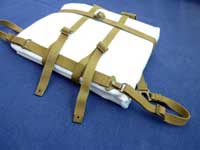
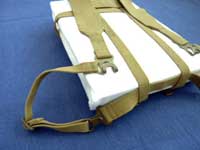 Laid flat, the Carrier is a bit 2-D, so Lee has placed a dummy load in the Carrier, the better to show how it looked in use and how the loop / hook strap functioned.
Laid flat, the Carrier is a bit 2-D, so Lee has placed a dummy load in the Carrier, the better to show how it looked in use and how the loop / hook strap functioned.
Whilst it was usual to have a rectangular bundle, vertically orientated, the second photo at right shows how the loop / hook strap could be brought further up the load, without compromising its function.
It is speculated that the Carrier, coat was supplanted by Straps, utility by 1936.
With acknowledgements to John Bodsworth for the Patent drawings and André Fernandes for the hand-book Equipamenta Mills m/1914. Descrição e instrução o seu uso.


